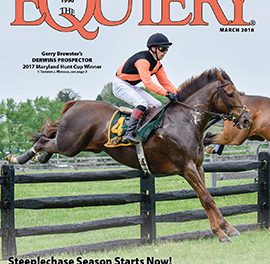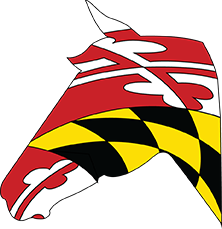From former Maryland Horse Council president Stewart Pittman, current Anne Arundel County Executive
| April 27, 2023
Dear Neighbor, It’s been a hell of a week for Maryland Thoroughbred racing, and I’ve kept my mouth shut…until now. Hooray for the horsemen, the men and women who own, train, and care for the magnificent animals that are the stars of the sport. They refused to race their horses because they believed that the racing surface at Laurel Park was unsafe. They chose horse welfare over purse money, even as 1/ST Racing, the Canadian company that owns Laurel and Pimlico, insisted that the surface was safe. I’ve never raced a horse, but I’ve transitioned a lot of racehorses to second careers and rehomed them. I also created a national organization to promote that retraining and rehoming called Retired Racehorse Project. Doing that work taught me two things. One is that Thoroughbred racehorses love to run and love to connect with competent handlers and riders. The other is that the people in horse racing will do anything and everything to nurture and protect the magnificent animals in their care. This isn’t the first time that track owners and horsemen have disagreed with one another, but it’s happening at a high stakes moment for the industry. When Maryland voters approved slots in 2008, they also approved an arrangement to distribute its revenues. Most goes to an education trust fund, but some is a payback to an industry that lost gambling dollars to slots – horse racing. There is purse money and there is a Racetrack Facilities Renewal Account (RFRA) to maintain the tracks. Laurel and Pimlico are both crumbling. The Maryland General Assembly authorized the industry to sell bonds to finance a rebuild of both tracks to be paid back with funds from RFRA. Both the financing and the construction would be overseen by the Maryland Stadium Authority (MSA). MSA worked hard to get both projects shovel-ready, but progress with 1/ST Racing was slow. Interest rates and costs rose during that time and reduced drastically what could be built with the dedicated funds. Governor Moore, House Speaker Jones, and Senate President Ferguson wisely said no to 1/ST Racing’s plea for additional resources, but understood that the company was no longer a dependable partner to operate Maryland’s tracks. In the final days of the session, they moved through a bill to create the Maryland Thoroughbred Operating Authority, a new locally controlled entity that could step up and manage racing after a 1/ST Racing departure. It’s fair to say that Maryland racing is about to undergo some changes, and some big questions need to be answered. If there’s only enough money for one track, where should it be? Laurel? For the short term, yes. But there are environmental challenges that make it very expensive to rebuild there. The turf track is wonderful, but the dirt surface has foundational challenges that nobody has fixed. The land is at an underutilized MARC train station and has potential for other uses, such as recreation, entertainment, and housing. Pimlico? The upside is that it allows the Preakness to stay in Baltimore, and potentially benefits the residents of the surrounding Park Heights neighborhood. But like Laurel, it’s possible that a track isn’t the best economic driver compared to alternative uses for the land. That’s for Mayor Scott and his economic development team to determine. The clear downside to Pimlico as the sole track in Maryland is that it lacks the land to stable 1,100-plus racehorses. Should there be a training center elsewhere for horses that race at Pimlico? Or should there be a single track at a new location that can accommodate racing and training, and maybe even some other horse sports? And here’s a big question a lot of people are afraid to ask. Is Maryland racing worth saving? Attendance and betting handle at most major race days across the country – Triple Crown races, Breeders Cup, Pegasus – are growing, making them economic drivers where they happen. That will happen again around the Preakness, Maryland Million, and a revitalized Washington International with strong local management and marketing. The farms where Thoroughbred racehorses are bred and raised are an environmental and open space asset. A well managed pasture is second only to a forest in filtering nutrients that too often end up in our waterways. The 21,000 jobs and $1.3 billion economic impact of the industry is significant, but when you consider how difficult the job skills are to transfer, the value grows. Nobody is getting rich caring for horses, but the jobs are fulfilling. Horses don’t care about their handler’s race, national origin, or wealth, and that’s why the industry produces business owners and success stories from all walks of life. An effective trainer or jockey will succeed. Finally, there is something that horses do for people that makes us better. We are inspired by their honesty, their heart, their generosity, and their athleticism. When we connect with them, we connect with something we can’t fully control. We are humbled. The horse racing industry, and the non-racing parts of the horse industry are co-dependent. The trainers, the veterinarians, the exercise riders, the feed and equipment suppliers often have a foot in both worlds. Maryland has a network of stables where anyone can get started with horses, and the racetracks offer tours of the backside so that fans can see how the horses live and train. State and local governments promote sports and recreational activities that are good for health and that are economic drivers. Racing is both. As for the horses, I can’t speak for them. But I can say that it’s the racing industry that has led all horse sports on the welfare front. It’s the one that bans slaughter, it’s the one that funds the best veterinary research, and it’s the one that sets the standard for care. When I was president of the Maryland Horse Council, someone asked me if I were reincarnated as a horse and could choose a sport, which one would it be. I immediately said racing. It’s running with the herd and spending long hours eating the best food and sleeping on a clean bed of straw in front of a fan. So my long answer to the big question is yes. I am willing to follow the lead of the Maryland horsemen and women who bravely stood up for their horses this week, taking the sport local, and creating a future for Maryland racing, where horses come first. Until next week, Stewart Pittman Anne Arundel County Executive |
|












